Model of the mind
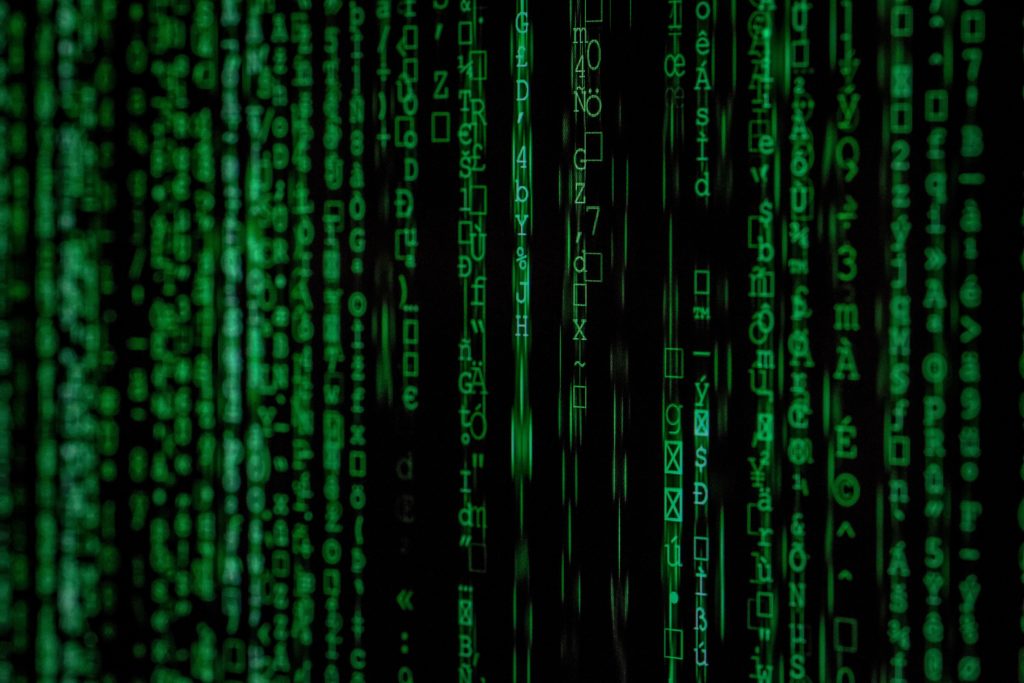
The human being: an open system
Humans are an open system, which means that their behavior is dependent on external influences in the form of INFORMATION.
This information is not limited to consciously perceived information, but also includes all external information in the form of light rays, sound waves, pressure waves, heat and chemical molecules.
The computer as a reference model
The computer is the most complex open system that man has constructed in his image. This is why we use this metaphor to explain the functioning of the HUMAN system.
If we look at the functioning of a cell, we realize that the cell not only functions like a computer, but is a real little computer. (Bruce Lipton, stem cell research, USA)
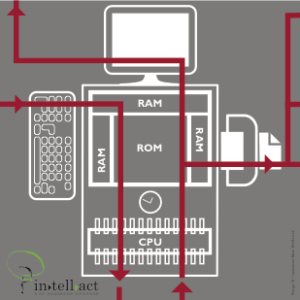
At the beginning, information hits the system. In computers, this usually happens via the keyboard, in humans via the sensory organs. This is the IN area of the IN˃TELL˃ACT-model.
From here, the information is transferred to the two memories of the system, first to the modifiable memory, which can be rewritten at any time. In a computer, this is the RAM memory (Random Access Memory). In humans, this is all experienced and stored events.
The brain can be compared to a computer
The brain processes about 400 billion bits of information per second.
However, only 2,000 bits of this data would reach the conscious mind.
Dispenza, J. (2008). Change your consciousness: The science of changing minds. Health Communications, Inc.
The conscious part represents only an extremely small part (0.000001%), in relation to the unconscious part (subconscious, unconscious).
We would send out 50,000 to 60,000 thoughts per day (i.e. 2,500 per hour or 41 thoughts per minute)
Change Your Brain, Change Your Grades written by psychiatrist, neuroscientist and cerebral health expert Dr. Daniel Amen
most of which is automatic and unconscious (90-95%),
and corresponds to the thoughts of the previous day.
The consciousness
Analyze and solve problems:
Developing a logical construct.
How do I do that? What for?
The rational side:
Explains our behaviors, actions and decisions by giving them meaning and reason.
This justification is almost always false, often borrowed from the environment, and this is never the real reason.
In the absence of this justification or meaninglessness, the individual becomes anxious or even ill.
The will:
A short-term tool that can neither replace the subconscious nor bring about lasting change.
Short-term memory:
stores only the information that is useful in everyday life, the names of our neighbors, telephone numbers, where the keys are, etc. …
The subconscious
Is programmable and has a unique algorithm that turns us into the kind of person it wants us to be,
perceives from our previous data.
If the previous programming says that we are smokers, the subconscious will do everything to make us smokers. The same applies to success and failure.
It can make us whatever it wants: make us fat or thin, poor or rich.
The program collects data from everywhere by summarizing and collating it
back to our birth to reinforce what it already understands.
Changing a routine element, that is, implanting a permanent suggestion, amounts to changing obsolete program parts that were once useful (subconscious is protective) and are no longer relevant.
So let’s update our software.
It contains our long-term memory
Our programs and programming habits are stored there with their data.
At the beginning it is empty of data and unfolds every moment with information from our daily experience.
We think to forget, but the data is never erased, it’s just a matter of being able to remember it.
The subconscious writes down everything, forgets nothing, including images, sounds, smells, sensations,
including feelings and emotions, throughout life.
The subconscious mind is powerful, very intelligent but also irrational
It is just a program, does not think about any decisions,
but applies its programming, whether the result is good or bad is not at its discretion.
It cannot distinguish between truth and lies, reality and perception or imagination.
Although extremely strong, our subconscious is designed to hold on to what has worked for our survival so far.
Where we want it to be, it doesn’t like to do the work necessary to bring about positive change.
It likes things to stay the way they are because it takes effort to make positive changes.
Placing positive suggestions in our subconscious is one of the most difficult things there is.
On the other hand, negative suggestions penetrate the subconscious mind like butter,
because there is no significant effort to accept negative suggestions.
He is also lazy in that respect:
prefers to reinforce what exists and what works for it in its own logic, rather than make an effort to change it.
It contains the roots of personality. It contains our habits
There are only three types:
good, bad and useful like,
always taking the same route to work, picking up the phone when it rings,
tying your shoes or shaking someone’s hand and so on…
It contains our emotions
Positive and negative, love, hate, fear…
The conscious mind cannot process emotions because they are exclusively subject to the subconscious,
and when they interfere in a situation, it’s the very intelligent but also very irrational and sometimes juvenile subconscious mind that runs the show here, with the rationale often saying, “But why did I do that? “
The subconscious is our protector
It’s its number one priority.
It has managed to bring you here, alive, in this moment.
You can trust it. We need to change the obsolete program bits that were once useful and are no longer needed. In short, let’s update our software, hypnosis makes it possible.
The Three Levels of Consciousness
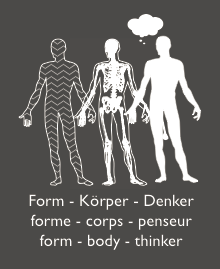
The workings of life and especially consciousness still remain a great mystery to science. Modern imaging techniques allow us to look more and more closely into the brain and even observe how it functions. But with every new insight, new questions are raised.
In order to visualize the IN>TELL>ACT concept, the human concept was divided into three levels: the thinker, the body and the form. Each level is also assigned a consciousness.
This is how the thinker works with mental consciousness,
the body with the body consciousness
and the form with the form consciousness.
Although all three levels work together simultaneously and in parallel and cannot be separated from each other, we can use this tripartite division as a working model for understanding the strategy and for working on these strategies.
a) Form consciousness
According to Rupert Sheldrake, the information for the developmental form of a living being is present in the universe as a morphogenetic field. Rupert Sheldrake ist die Information für die Entwicklungsform eines Lebewesens als morphogenetisches Feld im Universum vorhanden. According to “Global Scaling”, the morphogenetic field corresponds to the body’s own vibration at the lowest energetic level. This applies not only to the body as a whole, but also to every organ and every cell. Like all matter in the universe, from a purely physical point of view, the human body also has the urge to vibrate at this lowest energetic level.
b) The body consciousness (body)
The body consciousness controls the material body, which has grown into the morphogenetic field, the “ideal self”, in the course of the individual’s development and changes in this field over time. It functions in the moment and knows neither past nor future. All information is organized in parallel, not linearly as in mental consciousness. According to this model, the body consciousness strives at all times to conform to the bodily and physical form of the “ideal self” (state at the lowest energetic level).
c) The mental consciousness (thinker)
The mental consciousness contains our thinking and the conscious will. The mental consciousness is time-bound and enables us to compare, justify, think logically and plan. But it is not directly involved in the process of survival, although it can influence it indirectly.
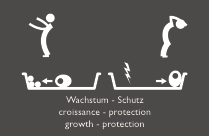
Growth or protection
A single cell can either grow or protect itself. Both are not possible at the same time. In a complex system, such as the human system, it is possible for different parts to be in a growth process while other parts remain in a protective mechanism. A system only functions perfectly when all its parts are in the process of growth. Every living being strives to achieve this state.

Evolution
It is becoming increasingly apparent that modern man also functions to a very large extent like his ancestors thousands of years ago. Even the brain has not yet adapted to the conditions of the 21st century and reacts in a rather primeval way to external conditions. Most forms of behavior are also evolutionary and can be found in both humans and animals.

Information – Energy – Representation
We know from quantum physics that both photons and particles of matter can behave not only like particles, but also like waves. When working with “IN>TELL>ACT”, it is therefore important to know the relationship between information, energy and representation (as matter). The material representation is a representation made visible, audible or tangible by energy. Information. Information is always present and is bound neither to space nor to time. Energy makes the information recognizable, it can transport it and change its representation. The material representation is the energetically recognizable information that is created when it hits a calibrated receiver (other energy/information). A simple example of this principle is the projection of a slide onto a screen. The slide is the information, the projector lamp is the energy and the screen enables the display. If one of the three elements is missing, there is no exchange of information.
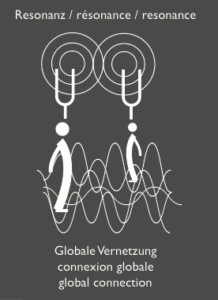
Universal communication through resonance
Thanks to modern quantum physics, we also know about the possibility of spaceless and timeless communication between two quantum particles. How far this can be transferred to the atomic level is still an open question. However, recent research in this area is showing more and more clearly that global communication exists and that it is possible to create resonance between two systems so that they can then communicate with each other. This principle can also be observed in the field of human communication, even if the scientific background of such communication has not yet been researched or communicated.
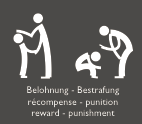
Reward – Punishment
The principle of reward and punishment has not found its way into education for nothing, because this is a general element of behavioral biology that makes a person what they are. It is a component of every strategy development that is not always visible. Everything that leads to saving the system from collapse, i.e. from death, is seen by the system itself as a reward (Henri Laborit).
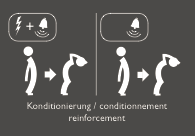
Conditioning
In combination with the principle of reward, the principle of conditioning is the strongest force in the development of a strategy. Since Pavlov, we have known that a signal that is received together with the satisfaction of a biological need can later take over the role of the need. For example, a person protects himself from a life-threatening danger and at the same time hears the sound of a bell. If danger and the sound of a bell occur together several times, the sound of the bell, although harmless, is enough to trigger the protective reflex unconsciously and automatically. What would still be justifiable in nature often becomes unbearable in everyday life, because this mechanism bypasses our mental consciousness in such a way that we can no longer explain and understand our own reactions and our own physical and bodily behavior. People tend to believe that they consciously decide to act the way they do. However, the principle of conditioning raises the important question of the free will of the individual.

The repetition
Until a century ago, the principle of repetition always applied in nature. In nature, the probability that a phenomenon will repeat itself has always been greater than the probability that something will change. This is different in our century, but for the human system, this change has not yet reached the physical consciousness and it still reacts in the same way as prehistoric man. So we have to incorporate the persistence of our system to adapt to a repetition into the strategic concept. Every strategy is based on this power to leave everything as it is and let our lives run as a series of automatisms. Through the knowledge of this urge to repeat, our unconscious automatisms become suggestions that can be accepted or rejected.
Conclusion
If you want to change a strategy that no longer seems adapted to the given circumstances, the first step is always to recognize what has happened so far. The strategy you want to change has at least allowed the system to be alive enough to think about it. The second step leads in the direction of conditioning. If I know what conditioning has brought about my strategy, I can also find the point to lift it out of its anchoring. Since it then always threatens to return to its old position, I have to prevent it from doing so by initiating a de-conditioning process.
